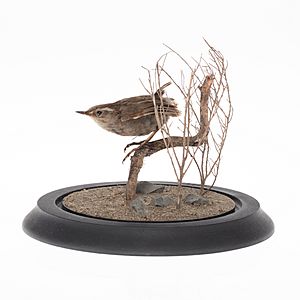Bushwren facts for kids
Quick facts for kids Bushwren |
|
|---|---|
 |
|
| Xenicus longipes mount in the collection of Auckland Museum | |
| Conservation status | |
| Scientific classification | |
| Genus: |
Xenicus
|
| Species: |
longipes
|
The bushwren (Xenicus longipes), also called the bush wren or mātuhituhi in Māori, was a very small bird from New Zealand. It was almost unable to fly and lived only in New Zealand. There were three types (subspecies) of bushwren. Each type lived on one of New Zealand's main islands: the North Island, South Island, and Stewart Island.
Sadly, this special bird slowly disappeared. This happened after new animals, called invasive predators, were brought to New Zealand. The last bushwren on the North Island was seen in 1955. On the South Island, the last sighting was in 1968. People tried to save the few remaining birds on small islands near Stewart Island. But these efforts did not work. The last known bushwrens died in 1972.
Contents
What did the Bushwren look like?
The bushwren was a tiny bird. It grew to about 9 cm (3.5 inches) long. It weighed around 16 grams (about half an ounce). That's lighter than a few coins!
This little bird mostly ate invertebrates. These are small creatures like insects and spiders. It would run along tree branches to catch its food. Bushwrens built their nests on the ground or very close to it.
Why did the Bushwren disappear?
Bushwrens used to live all over New Zealand's main islands. But in the late 1800s, new animals were brought in. These included mustelids (like stoats and ferrets) and rats. These animals were not native to New Zealand. They became invasive predators. They hunted and killed the bushwrens.
North Island Bushwren
The North Island bushwren (X. l. stokesi) was seen less and less. After 1900, there were only a few confirmed sightings. These were in the southern Rimutaka Range in 1918. They were also seen in the Ureweras until 1955. There were possible sightings near Lake Waikareiti in 1949. Some were also seen in the Huiarau Range and on Kapiti Island in 1911. It seems the last group lived in the area that became Te Urewera National Park. This was around the time they became extinct.
South Island Bushwren
The South Island bushwren (X. l. longipes) also faced tough times. The last confirmed sightings were in Arthur's Pass in 1966. Another was in Nelson Lakes National Park in 1968. Since then, there have been a few unconfirmed reports. These came from Fiordland and Nelson Lakes.
Stewart Island Bushwren
The third type was the Stewart Island bushwren (X. l. variabilis). It was also called Stead's bushwren. This bird lived on Stewart Island/Rakiura and nearby small islands. It was known to be on Stewart Island until 1951. But feral cats likely caused its extinction there.
It also lived on Kotiwhenua (Solomon) Island. It was quite common there until the early 1960s. The bushwren survived on Big South Cape Island. This island had no predators. But then black rats (R. rattus) arrived there in 1964.
The New Zealand Wildlife Service tried to save the bushwrens. They caught six birds. They moved them to Kaimohu Island. Sadly, these birds did not survive. The last known bushwrens died out in 1972.
Gallery
See also
 In Spanish: Acantisita de matorral para niños
In Spanish: Acantisita de matorral para niños





